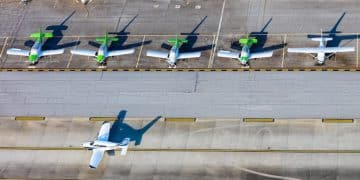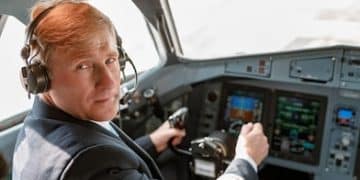Pilot Shortage Crisis: Airline Strategies for a Smoother Flight Path

The airline industry is currently grappling with a significant pilot shortage, prompting various strategies such as enhanced recruitment, accelerated training programs, and improved career pathways to mitigate the crisis and ensure continued operational capacity.
The airline industry faces pilot shortage: what strategies are being deployed to address the crisis? It’s a question that resonates deeply within the aviation sector and with travelers alike. What are the airlines planning to do to mitigate this growing issue?
Addressing the Looming Pilot Shortage: A Critical Challenge
The global airline industry is soaring, but not without turbulence. A critical challenge looming on the horizon is the increasing pilot shortage, threatening to disrupt flight schedules and potentially impact the growth of the sector.
This isn’t just a future concern; it’s a present-day reality forcing airlines to rethink their strategies and implement innovative solutions to attract, train, and retain qualified pilots.
Understanding the Causes Behind the Pilot Shortage

Several factors have converged to create the current pilot shortage. It’s a complex issue with roots in economic downturns, demographic shifts, and evolving career preferences.
Understanding these underlying causes is essential for developing effective strategies to address the problem.
The Impact of Mandatory Retirement Ages
One of the primary drivers of the shortage is the mandatory retirement age for pilots in many countries. As experienced pilots reach the age limit, a significant number of them are leaving the workforce, creating a vacuum that needs to be filled.
The Cost of Pilot Training
The high cost of flight training can be a significant barrier to entry for aspiring pilots. The expenses associated with flight school, certifications, and maintaining currency can be prohibitive, deterring many potential candidates from pursuing a career in aviation.
- Address financial barriers with scholarships and loan programs.
- Develop cost-effective training solutions.
- Make pilot education more accessible to diverse socioeconomic backgrounds.
The confluence of mandatory retirements and the financial challenges of pilot training has created a perfect storm, leading to the current pilot shortage. Addressing these issues head-on is critical for ensuring the stability and growth of the airline industry.
Strategies to Attract and Recruit New Pilots
Attracting and recruiting the next generation of pilots requires a multifaceted approach. Airlines are exploring innovative strategies to make the profession more appealing and accessible.
These strategies aim to broaden the talent pool and ensure a steady supply of qualified pilots for the future.
Enhanced Recruitment Initiatives
Airlines are ramping up their recruitment efforts by attending career fairs, partnering with universities and flight schools, and using social media to reach potential candidates. These initiatives aim to raise awareness about the opportunities available in aviation and attract individuals who may not have previously considered a career as a pilot.
Partnerships with Flight Schools and Universities
Collaborating with flight schools and universities is a key component of recruitment strategies. Airlines are establishing partnerships to offer scholarships, internships, and mentorship programs to aspiring pilots. These partnerships provide valuable hands-on experience and create a pathway for students to transition into airline careers.

- Expand partnerships with educational institutions.
- Offer mentorship programs.
- Improve flight training curriculum.
By enhancing recruitment initiatives and forging strong partnerships with flight schools and universities, airlines can effectively attract and nurture the next generation of pilots, ensuring a sustainable workforce for the future. The combined effect of these focused efforts should hopefully overcome the current pilot shortage.
Accelerated Pilot Training Programs: A Fast Track to the Cockpit
To meet the increasing demand for pilots, airlines are implementing accelerated training programs that allow aspiring pilots to complete their training in a shorter timeframe.
These programs combine classroom instruction, simulator training, and flight experience to prepare pilots for airline operations efficiently.
Streamlined Training Curriculum
Accelerated training programs often feature a streamlined curriculum that focuses on essential skills and knowledge. By eliminating unnecessary content and optimizing the learning process, these programs can shorten the training timeframe without compromising the quality of education.
Advanced Simulator Technology
The use of advanced flight simulators plays a crucial role in accelerated training programs. Simulators provide a realistic and safe environment for pilots to practice maneuvers, handle emergencies, and develop their decision-making skills. This technology significantly enhances the learning experience and prepares pilots for real-world scenarios.
Accelerated pilot training represents a significant step toward mitigating the pilot shortage by providing a faster, more efficient route into the cockpit. Through streamlined curriculums and advanced simulator technology, it is possible to significantly increase throughput.
Enhancing Pilot Career Pathways and Retention Strategies
Retaining experienced pilots is just as important as recruiting new ones. Airlines are implementing strategies to enhance career pathways and create a more attractive work environment.
These initiatives aim to improve job satisfaction, reduce turnover, and ensure that pilots remain committed to their careers within the airline.
Competitive Compensation and Benefits Packages
Offering competitive compensation and benefits packages is essential for retaining pilots. Airlines are reviewing their pay scales, retirement plans, and health insurance options to ensure they are competitive within the industry. Additionally, some airlines are offering signing bonuses and other financial incentives to attract and retain top talent.
Improved Work-Life Balance
Addressing work-life balance concerns is critical for pilot retention. Airlines are exploring strategies to provide more predictable schedules, reduce layovers, and offer more time off. These initiatives aim to improve the quality of life for pilots and make their careers more sustainable over the long term.
- Offer predictable schedules.
- Reduce layovers.
- Improve communication.
By enhancing career pathways and prioritizing retention, airlines can reduce turnover and ensure a stable and experienced pilot workforce. These strategies also contribute to a positive work environment, which can attract new recruits and further alleviate the pilot shortage.
Technological Innovations as a Solution Multiplier
The airline industry is increasingly leveraging technology to enhance pilot training, improve operational efficiency, and ultimately alleviate the pilot shortage.
These technological innovations not only increase the capacity of training programs, but also improve the overall effectiveness of the airline industry.
AI-Powered Training Programs
Artificial intelligence (AI) is being integrated into pilot training programs to personalize the learning experience and provide customized feedback. AI-powered systems can analyze pilot performance, identify areas for improvement, and provide targeted training exercises. This technology allows instructors to provide more individualized attention and optimize the learning process for each student.
Automated Flight Systems
Advancements in automation are transforming the way pilots operate aircraft. Automated flight systems can handle many routine tasks, reducing the workload on pilots and allowing them to focus on critical decision-making. While automation will not replace pilots entirely, it can enhance safety, improve fuel efficiency, and increase the overall efficiency of flight operations.
By embracing technological innovations, the airline industry can enhance pilot training, improve operational efficiency, and mitigate the pilot shortage. The integration of AI and automation is paving the way for a more efficient and sustainable aviation future.
| Key Point | Brief Description |
|---|---|
| 🧑✈️ Recruitment Initiatives | Airlines are enhancing recruitment to attract more pilots. |
| 🚀 Accelerated Training | Fast-track programs help pilots qualify quicker. |
| 💰 Compensation & Benefits | Better pay and benefits retain experienced pilots. |
| 🤖 AI Training | Use of AI to personalize pilot education. |
Frequently Asked Questions (FAQ)
▼
The pilot shortage is caused by several factors, including mandatory retirements, the high cost of flight training, and an increase in demand for air travel. All of these issues, when combined, cause significant disruptions.
▼
Airlines are using enhanced recruitment initiatives, such as attending career fairs and partnering with flight schools. Also, many airlines are working to raise awareness about aviation careers through social media campaigns.
▼
Accelerated training programs streamline the curriculum and use advanced simulator technology. This method allows aspiring pilots to complete their training in a shorter timeframe while still gaining essential skills for their work.
▼
Retaining experienced pilots is vital because it ensures a stable and skilled workforce. Airlines focus on competitive pay, benefits, and better work-life balance to keep pilots committed to their careers in the long term.
▼
Technology helps by improving training efficiency through AI-powered systems and easing workloads with automation. These advancements allow airlines to train more pilots effectively and streamline flight operations.
Conclusion
In summary, addressing the pilot shortage requires a comprehensive strategy that includes attracting and recruiting new pilots, accelerating training programs, improving retention efforts, and leveraging technological innovations. By implementing these solutions, the airline industry can mitigate the impact of the shortage and ensure a stable future for air travel.





